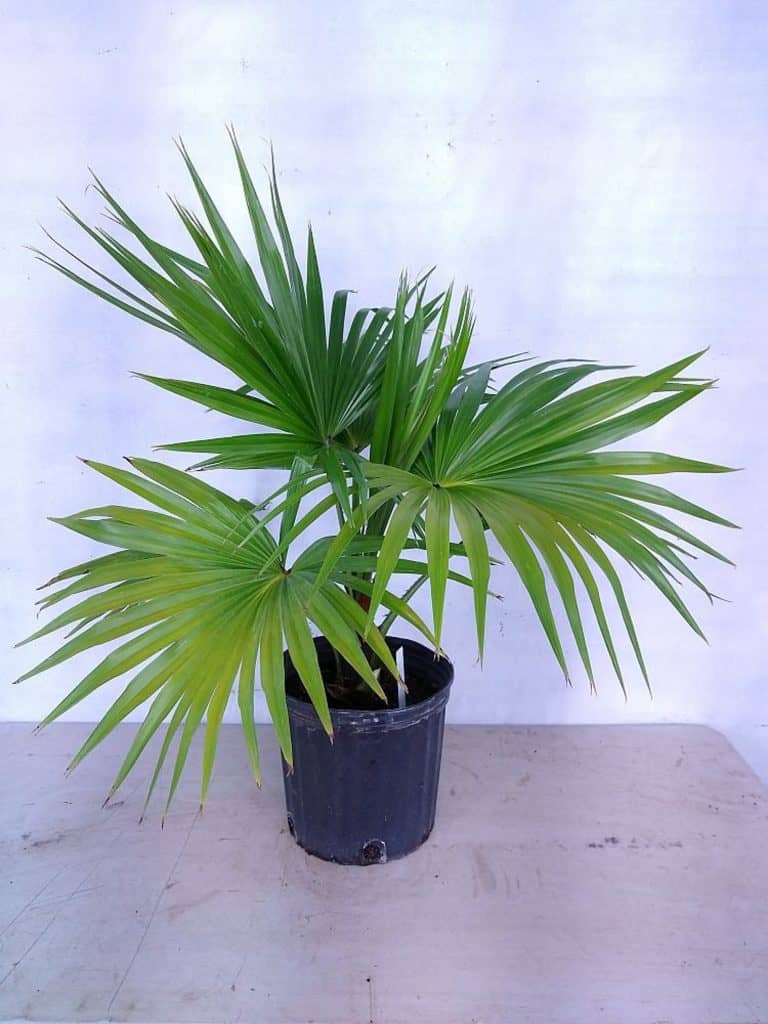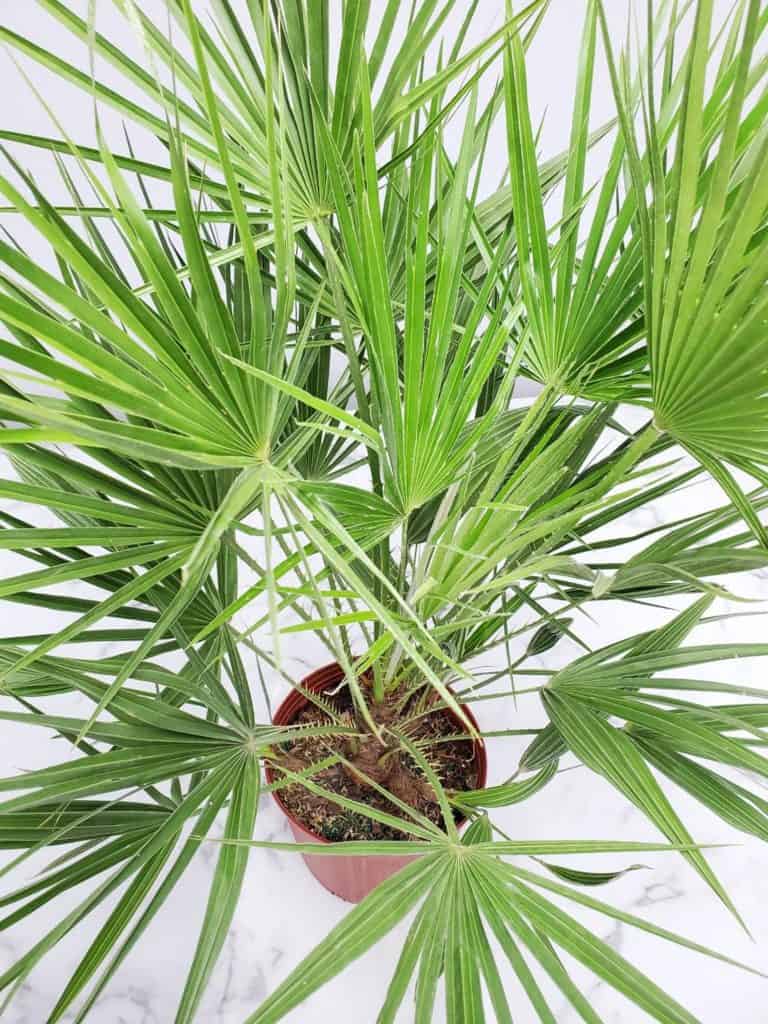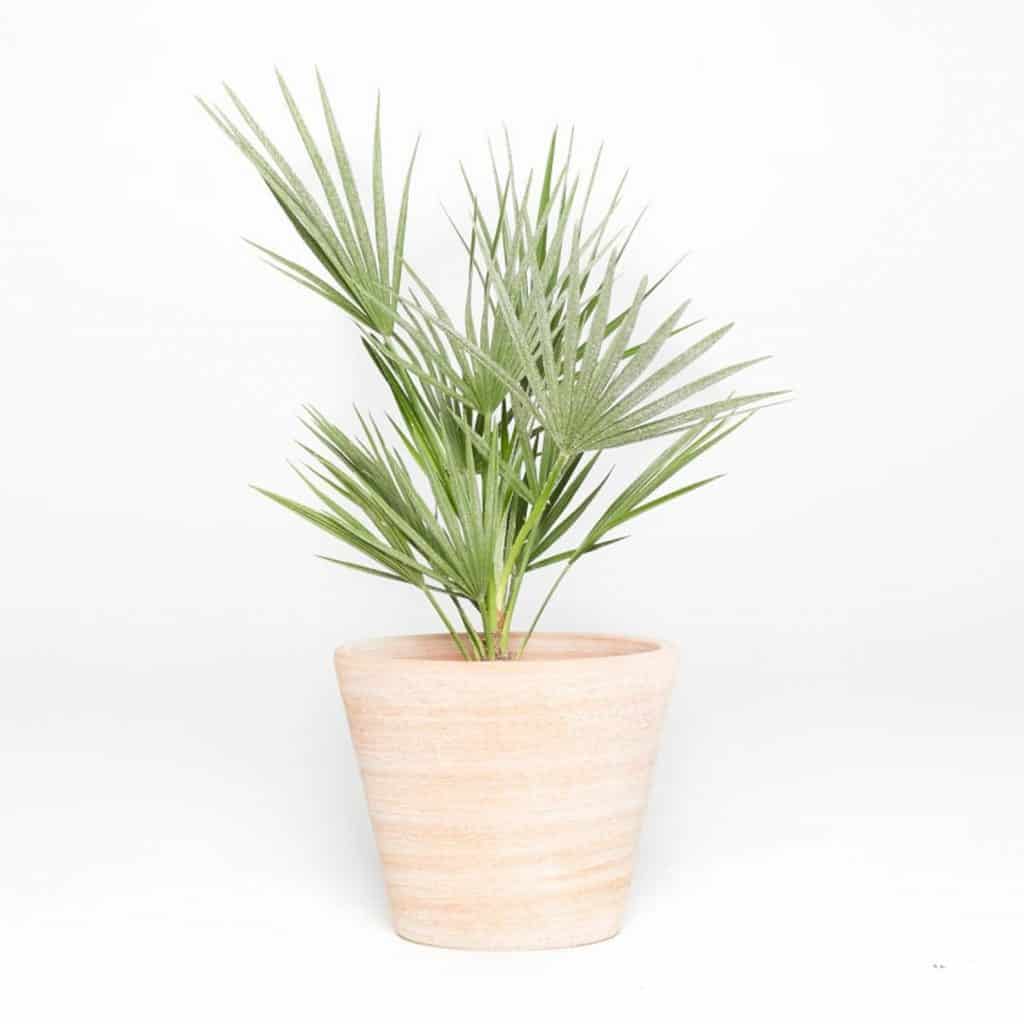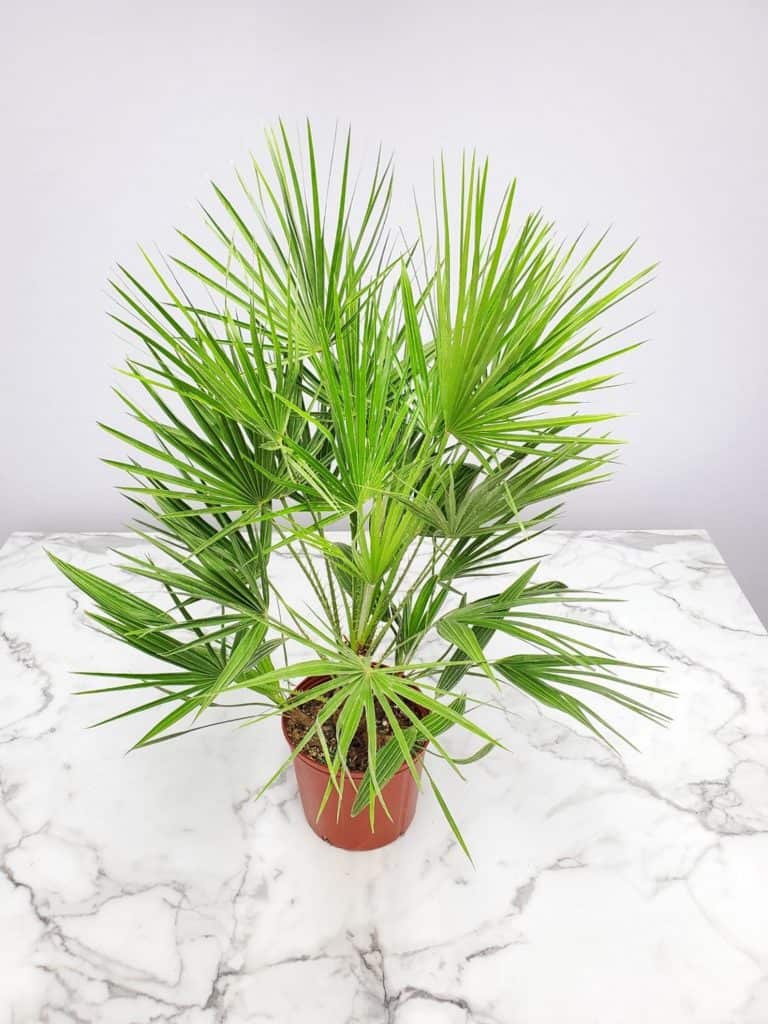The Chinese Fan Palm, also known as the Fountain Palm, is a stunning plant both as an outdoor plant and an indoor plant! It’s a very hardy plant that’s drought resistant making it a great option for beginners or those who tend to be a bit more forgetful!
Known for being a favorite to South Florida, the Chinese Fan Palm is one of the most beautiful and exquisite plants that people put in their backyards. It has a wide spreading crown and large fan-shaped leaves, it makes a great privacy plant and it’s great for those who want to have a tropical garden.
It’s beautiful foliage also makes a great indoor palm! It’ll be a great conversation starter when guests stop by for a visit. Everyone will want to know about this incredible plant!
Table of Contents
History and Background
The Chinese Fan Palm tree, botanical name Livistona chinensis, is originally from southern Japan and China. It’s known as the Chinese Fountain Palm as well because it resembles a flowing fountain with the trunk and the leaves coming out of the middle.
There are three main different kinds of fan palms: the European Fan Palm, which is native to Europe, the California Fan Palm, which is native to the United States, and the Real Fan Palm.
The real fan palm is native to subtropical regions in Africa and can be a great source of food for these individuals. Other than this, the Chinese fan palm is one of the most popular plants.
One thing to note is that this plant has been labeled an invasive plant in Florida, Hawaii, and Bermuda. It can easily escape gardens so be careful if you’re planting this outside in those areas!
The Chinese fan will grow from a single trunk and can grow up to 30 feet. This is incredibly tall, but it’s a great slow grower and one that takes many years to develop.
*You can check out some of my favorite tall succulents here!
It’s not very cold friendly, making it incredibly difficult for those to grow who are not within these more humid and hot areas.
However, there are many ways you can care for your Chinese fan palm, and ways that you can create an inside plant out of this species.
Chinese Fan Palm Care Tips

This post includes affiliate links.
Lighting
Keeping these plants healthy is all about sunshine and humidity. After all, they are native to East Asia – China and southern Japan – where it’s incredibly hot at certain times of the year.
The exposure for this tropical plant should be indirect light to full sun. It needs a good amount of light in order to grow.
The proper amount of time that your Chinese fan palm should stay in the direct sunlight is about four hours every single day.
For many of these plants that are indoors, you probably need to have a South or West facing that window in order to have the proper sunlight. Otherwise, you could risk damaging or hurting your plant.
Watering
Because these plants are more comfortable in humid and hot environments, this plant definitely needs more water than most. However, allowing the plant to dry out during the winter is more beneficial than in the summer.

Image via Etsy (where you can purchase this!)
Most days, you’ll need to at least do a daily misting of the plant in order to keep the humidity high. However, you’ll be able to tell if it needs extra misting or water as well.
If your plant is starting to look a little brown, you probably need to spray it because it’s a little bit too dry. This is a great indicator for you to tell if you need water.
Setting alarms on your phone to remind yourself when to water it is a great way to stay on top of it!
Soil
When it comes to the soil type for palm plants, you need to have a well-drained soil. You also want to make sure that your pot has good drainage holes to allow the water to drain well.

Image via Etsy (where you can buy it!)
Keep in mind the seasons. The growing season, or summer months, is when you should have your plant moist at all times but also make sure it doesn’t have soggy soil. There’s a good balance between soil that’s moist but oversaturated.
However, it’s important to make sure that you don’t overwater. Make sure that you continue to water when appropriate, and make sure that you’re not keeping the plant too dry or too wet.
Fertilizer
While not needed all of the time, fertilizer can be useful during some of the drier months. In the late winter through the early fall, fertilizer can be a great way to help make sure that your plant stays healthy.
This is incredibly important to make sure that it isn’t too dry or isn’t too wet, and also is more prepared for the months ahead that could be more difficult for it.
This is even more important people in drier climate, where it’s more difficult for you to get the proper environment for your plant.
Temperature
For indoor Chinese fan palms, it’s not too hard to keep them happy in a particular temperature. As long as you have the temperature between 65 to 85 degrees Fahrenheit, you will not have too many difficulties with your indoor plants. However, you need to keep in mind to keep it away from significant heat or cold waves.
This includes any placement of this plant near a heating or cooling vent, or even ceiling fans. These can cause individual temperature fluctuations and actually harm the plant.
This should be avoided if at all possible, in order to make sure that your plant thrives in the environment that you have it in.
Humidity
As mentioned, southern Japan and China are incredibly warm compared to what many people believe it to be. This is why the Chinese Fan Palm needs to have a moderate amount of humidity, or even a high amount in certain months.

Image via Etsy (where you can buy it!)
The most efficient way to increase humidity for your plant is to use a humidifier. Another way to increase humidity is to mist your plant. This isn’t always the best option but worth trying if you don’t have a humidifier.
If your plant is looking a little brown, make sure you add a little bit more water and consider getting a humidifer.
On the other hand, you also need to watch out for overwatering in order to not kill the roots or the plant itself.
Toxicity
Luckily for those who are animal lovers, the Chinese fan palm is actually very friendly for pets. Whether you have a cat, dog, or even a horse, this plan is friendly, and doesn’t even harm your animal.
Even if your pet gets a nibble on a few of the leaves, there’s still no worry as to their health, or sending them to the pet ER.
Pests
Unfortunately, there are some issues to take into account for pests. If you have any dusty foliage, there can be a problem concerning spider mites or scale insects.
This is why it’s a critical in order to make sure that your palm fronds are wiped clean on a regular basis. If you do not do this, you can have a mite problem.
In order to get rid of your mite problem, you need to use a soapy water mixture or insecticidal soap to control the infestation, and use this regularly. Make sure to keep doing this until you see the end of the mites, but also make sure that you don’t do too much of this in order to hurt your plant. This would be incredibly catastrophic, or results in the loss of a very beautiful house plan.
Pruning
Luckily for those who are concerned about pruning, the Chinese Fan Palm does not need that much pruning. They will continue to develop their shape on their own, making incredibly easy for you to enjoy their beauty with ease.
Never trim your plant from the top of the plant. New growth comes from the top of this plant so if you cut it off you won’t see new growth!

Image via Etsy (where you can buy it!)
However, it’s not always a bad idea to make sure you prune off the dead leaves. At the bottom of the crown once a year or even as often as you see them, you can take the dead fronds and cut them off.
You need to make sure until the fronts of completely turned brown before you remove them. Otherwise, you might end up removing a perfectly good leaf that was trying to recover, rather than just removing older fronds that are dead.
Repotting
Luckily for those who buy the Chinese fan palm in a container, you don’t really have to repot these as often as other plants. This is because the roots are incredibly fragile and can be damaged if you do this often.
This is why many people end up having the same pot for much of the existence of this plan. However, if you want to change the soil out and make sure that it’s fresh, this is not always a bad idea.
You know that it’s time for a larger pot when you see the roots growing out of the drainage holes. When this happens, you’ll want to find a pot size that’s just slightly bigger than the original pot. You can gently scoop the root ball out of the old container and put it in the new one, filling it with fresh potting mix.
After this, water as you normally would, and you have a brand new plant in a pot. The best time to repot your plant is in early spring
Chinese Fan Palms grow best in partial shade to full sun.
These plants can take less water in the winter months. They can also benefit from misting.
Conclusion
Chinese fan palms are some of the most exquisite ideas for indoor house plants, and some of the best ones because of the fact that they are non toxic to pets. They can grow much larger in size than others, but they are still so beautiful and so great to have within your home.
If you’re looking to have a Chinese fan palm within your house, make sure you follow these steps, make sure you water it enough, and enjoy the beauty that this plan provided you over the many years that it is thriving within your home.
Want other larger plants? Check out one of these!

